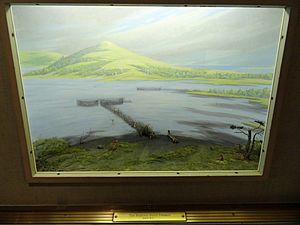Boylston Street Fishweir facts for kids
The Boylston Street Fishweir refers to very old fishing structures found deep under Boylston Street in Boston, Massachusetts. They were first discovered in 1913. These structures are buried about 29 to 40 feet (8.8 to 12.2 m) below the street.
Early reports from the 1940s thought these were the remains of one huge fishweir. It was believed to be 2,500 years old. This giant weir was thought to have up to 65,000 wooden stakes. It covered about 2 hectares (4.9 acres) of what used to be mud flats and marshland. This area is now the Back Bay part of Boston. However, new evidence and modern archeology offer a different idea about these findings.
Contents
What are Fish Weirs?
Fish weirs are like wooden fences built in water to catch fish. People use them all over the world. They are a simple way to trap fish as the tide goes in and out, or in rivers.
How They Work
In places with big tides, where the water level changes a lot (12 to 20 feet (3.7 to 6.1 m)), weirs are built with thick poles. These poles are about 4-to-6-inch-diameter (10 to 15 cm). They hold woven nets. In shallow water or small streams, weirs might use thinner stakes. These stakes are about 1-to-3-inch-diameter (2.5 to 7.6 cm). They have brushwork woven between them to form a barrier. This barrier traps fish when the tide is at a certain level.
Who Used Them?
Native peoples in coastal areas all over the world have used fish weirs. Some weirs found are as old as 7,500 years. In some places, like Yap, Federated States of Micronesia, people still build and use fish weirs today.
In North America and Europe, you now need special permission to build a fish weir. Sometimes, building them is not allowed at all. This is often because of fish populations or how people use the water. This has been a concern for Native American groups along the New England coast.
Finding the Ancient Fish Weirs
The first discovery of these ancient structures happened in 1913. Subway workers were digging tunnels under Boylston Street. They found wooden stakes buried 32 feet (9.8 m) deep in blue-gray clay. The workers destroyed many stakes. But enough evidence was found for researchers to think they had discovered a large fish weir. They believed it was 2,000 years old.
More Discoveries in the 1930s
More fish weir parts were found in 1939. Archeologist Frederick Johnson led investigations. This happened during digging for a new building at 501 Boylston Street. They found long lines of wooden stakes. These stakes were buried under tidal mud and 15 to 20 feet (4.6 to 6.1 m) of 19th-century fill.
Maps were drawn showing a fish weir covering over 2 acres (8,100 m2) of the old marshland. This suggested one very large fish weir with over 65,000 wooden stakes. People thought a big community must have built it all at once. It was even called the earliest known large engineering project in North America. Drawings and models showed the weir in deep water. They imagined men working from mishoons (log canoes) to maintain it. This idea might have come from how Native peoples used weirs in the Canadian Bay of Fundy in the 1940s.
New Ideas from Later Finds
Archeological research continued in 1946. This was during the building of the John Hancock Building. Here, they found 2-inch-diameter (5.1 cm) wooden stakes. They were 3 to 4 feet (91 to 122 cm) long and arranged in parallel lines. Researchers then thought these were parts of long wooden structures. These structures were likely built across streams on old tidal flats. This new evidence suggested weirs made to trap fish in shallow tidal areas. People now thought fish were collected by hand, by wading from shore, or by waiting for low tide.
Boston's Changing Coastline
Studies of climate change and the fish weirs show something important. The ocean level in Boston has risen more than ten feet in the last 6,000 years. The wooden stakes found show that the fish weirs were built close to the changing shoreline. As the ocean rose, these weirs were rebuilt each season in higher spots.
Scientists used tree ring dating to study the wood. They found that the types of wood used changed with the climate. These woods included sassafras, hickory, dogwood, beech, oak, and alder. Tree rings and bark also showed that the wood was often cut in late winter. Construction work on the weirs happened in the spring.
Life with the Weirs
When the fish weirs were in use, the difference between high and low tide was only about 3 feet (0.91 m). This made it easy to build and fix the wooden structures. People could also walk from the shore to get the trapped fish.
The oldest weirs were built almost 5200 years ago. They were rebuilt again and again for over 1500 years. But around 3700 years ago, the daily tides became much bigger. The ocean level had risen too much. The small wooden weirs were no longer useful in the Back Bay area. The Native people stayed in the area. They developed other ways to fish and plant food. The people living in Boston today, like members of the Massachuset tribe, might be their descendants.
Future Discoveries
New buildings in Boston’s Back Bay will likely uncover more fish weir evidence. Samples of weir stakes and survey information from earlier archeological work still exist. More research is needed to fully understand the history of these fish weirs. It will also help us learn more about the early people who lived in the place we now call Boston for thousands of years.
The Ancient Fishweir Project is an event held every year on Boston Common. It honors this ancient history. They build a fishweir just two blocks from where the real ones are still buried.


